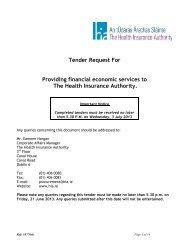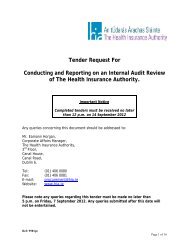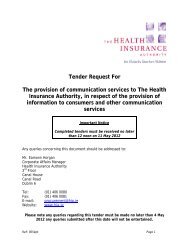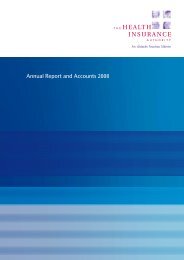Competition in the Irish Private Health Insurance Market
Competition in the Irish Private Health Insurance Market
Competition in the Irish Private Health Insurance Market
Create successful ePaper yourself
Turn your PDF publications into a flip-book with our unique Google optimized e-Paper software.
The HIA publishes on its website a consumer guide, Understand<strong>in</strong>g and<br />
Compar<strong>in</strong>g <strong>Private</strong> <strong>Health</strong> <strong>Insurance</strong> Products 95 designed to help<br />
consumers compare <strong>the</strong> benefits provided by various PHI schemes. The<br />
publication of such data, similar <strong>in</strong> format to <strong>the</strong> cost surveys published<br />
regularly by <strong>the</strong> F<strong>in</strong>ancial Regulator, needs to be advertised widely.<br />
Search Costs<br />
6.33 Search costs, which can be dist<strong>in</strong>guished from switch<strong>in</strong>g costs, are<br />
def<strong>in</strong>ed as follows:<br />
“Search costs are <strong>the</strong> total costs spent by a consumer <strong>in</strong> identify<strong>in</strong>g<br />
and <strong>in</strong>terpret<strong>in</strong>g a firm’s product and price offer<strong>in</strong>g, regardless of<br />
whe<strong>the</strong>r <strong>the</strong> consumer buys <strong>the</strong> product from that firm or not.<br />
Switch<strong>in</strong>g costs are <strong>the</strong> total costs <strong>in</strong>curred by a fully <strong>in</strong>formed<br />
consumer through decid<strong>in</strong>g to change suppliers that would not have<br />
been <strong>in</strong>curred by rema<strong>in</strong><strong>in</strong>g with <strong>the</strong> current supplier.” 96<br />
6.34 Therefore, while switch<strong>in</strong>g costs are only <strong>in</strong>curred upon decid<strong>in</strong>g to<br />
switch, search costs may be <strong>in</strong>curred numerous times, and must be<br />
paid regardless of whe<strong>the</strong>r a consumer eventually decides to switch.<br />
This means that <strong>the</strong> search activity of consumers will be <strong>in</strong>hibited more<br />
by high search costs, which are an <strong>in</strong>evitable outcome of search<strong>in</strong>g,<br />
than by high switch<strong>in</strong>g costs, which only arise follow<strong>in</strong>g a successful<br />
search. Firms can <strong>in</strong>crease search costs through <strong>the</strong> use of<br />
“obfuscation strategies”, for example, deliberately complex tariff<br />
structures which consumers f<strong>in</strong>d difficult to compare.<br />
6.35 Consumer welfare can be <strong>in</strong>creased by reduc<strong>in</strong>g both switch<strong>in</strong>g costs<br />
and search costs. 97 Indeed, s<strong>in</strong>ce high search costs may be a more<br />
significant factor <strong>in</strong>hibit<strong>in</strong>g switch<strong>in</strong>g, reduc<strong>in</strong>g search costs may have<br />
a greater impact on competition and consumer welfare than reduc<strong>in</strong>g<br />
switch<strong>in</strong>g costs. This is because consumers have already completed<br />
search<strong>in</strong>g and are clearly sufficiently motivated once <strong>the</strong>y reach <strong>the</strong><br />
switch<strong>in</strong>g stage. Search costs are unlikely to deter highly motivated<br />
consumers. However, where consumers are not highly-motivated, <strong>the</strong>y<br />
may not even go to <strong>the</strong> bo<strong>the</strong>r of exam<strong>in</strong><strong>in</strong>g alternative suppliers if <strong>the</strong><br />
search costs of do<strong>in</strong>g so are too high. Reduc<strong>in</strong>g search costs will<br />
facilitate switch<strong>in</strong>g by consumers who are not highly-motivated.<br />
6.36 Both search and switch<strong>in</strong>g costs can be reduced if consumers have<br />
ready access to simple, understandable, high-quality price and product<br />
<strong>in</strong>formation. Where an <strong>in</strong>dustry is unable or unwill<strong>in</strong>g to provide this<br />
<strong>in</strong>formation, it may fall to an <strong>in</strong>dustry regulator or a consumer<br />
advocacy agency to do so.<br />
6.37 The F<strong>in</strong>ancial Regulator has also been proactive <strong>in</strong> provid<strong>in</strong>g consumers<br />
with straightforward <strong>in</strong>formation on frequently-complex retail f<strong>in</strong>ancial<br />
products and services through its websites, www.f<strong>in</strong>ancialregulator.ie<br />
and www.itsyourmoney.ie. The cost surveys which <strong>the</strong> Regulator issues<br />
95 Available onl<strong>in</strong>e at http://www.hia.ie/docs/pcaci/2006-Comparison-Table-September.pdf<br />
96 Wilson, C. (2006). “<strong>Market</strong>s with Search and Switch<strong>in</strong>g Costs”. Centre for <strong>Competition</strong> Policy<br />
Work<strong>in</strong>g Paper 06-10. Available onl<strong>in</strong>e at<br />
http://www.ccp.uea.ac.uk/public_files/work<strong>in</strong>gpapers/CCP06-10.pdf<br />
97 Wilson (2006), p.20<br />
94







